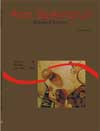<b>Hematological characteristics of Brazilian teleosts. I. Red blood cell and doses of blood plasma cortisol and glucose in <em>Colossoma macropomum</em> species in culture condition</b> - DOI: 10.4025/actascibiolsci.v20i0.4466
Abstract
Thirty approximately one-year-old sexually immature specimens of Colossoma macropomum Cuvier, 1818 (Osteichthyes: Characidae), total weight 500 to 700g, 25,0 to 30,2cm in standard length were used in this research work. Specimens were captured from tanks of Usina São Geraldo Fish Farm, Sertãozinho (São Paulo State, Brazil) and came from a single spawning. Average values for total count of erythrocytes, hemoglobin, hematocrit, mean corpuscular volume (MCV), mean corpuscular hemoglobin (MCH), mean corpuscular hemoglobin concentration (MCHC) were determined. Plasma glucose and cortisol were dosed. Results showed that the total count of erythrocytes in Colossoma macropomum was 2830.6 x 103/μl, hematocrit 41.6%, hemoglobin concentration 11.3g/100ml, MCV 150.0%, MCH 41.4pg, MCHC 27.7%, plasma glucose 116.7mg/dl and cortisol 182.1ng/ml. The number of erythrocytes presented positive correlation (α=0.05) with the hemoglobin rate and a highly positive correlation (α=0.01) with the hematocrit percentage while the hemoglobin rate showed a highly positive correlation (α=0.01) with hematocrit percentage.Downloads
Download data is not yet available.
Published
2008-07-21
How to Cite
Tavares-Dias, M., & Sandrim, E. F. S. (2008). <b>Hematological characteristics of Brazilian teleosts. I. Red blood cell and doses of blood plasma cortisol and glucose in <em>Colossoma macropomum</em> species in culture condition</b> - DOI: 10.4025/actascibiolsci.v20i0.4466. Acta Scientiarum. Biological Sciences, 20, 157-160. https://doi.org/10.4025/actascibiolsci.v20i0.4466
Issue
Section
Biology Sciences
DECLARATION OF ORIGINALITY AND COPYRIGHTS
I Declare that current article is original and has not been submitted for publication, in part or in whole, to any other national or international journal.
The copyrights belong exclusively to the authors. Published content is licensed under Creative Commons Attribution 4.0 (CC BY 4.0) guidelines, which allows sharing (copy and distribution of the material in any medium or format) and adaptation (remix, transform, and build upon the material) for any purpose, even commercially, under the terms of attribution.
Read this link for further information on how to use CC BY 4.0 properly.
0.6
2019CiteScore
31st percentile
Powered by 

0.6
2019CiteScore
31st percentile
Powered by 











1.png)




3.png)













